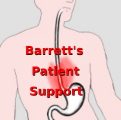Barrett's Oesophagus
Diagnosis
Diagnosing Barrett's Oesophagus is done by means of an endoscopy, a miniature camera put down your throat at a hospital. If you have a sedative it is often a completely painless procedure. Some hospitals offer trans-nasal endoscopy using a smaller instrument that is inserted through your nose. A Cytosponge test can also detect Barrett's oesophagus because of the presence of the TFF3 protein.
Patients with Barrett's are monitored at set intervals (sometimes every 2 years, but often less often, according to risk factors), and should go to have a check up if they notice any changes, say with difficulty in swallowing.
Surveillance monitoring involves checking for dysplasia, changes in the nature of the cells that might be leading to cancer. So Barrett's Oesophagus is not cancer; but for roughly 10% of the cases, adenocarcinoma cancer might develop, and it therefore acts as a precursor condition.
Identifying those most likely to have Barrett's Oesophagus
A full diagnosis of Barrett's Oesophagus can only be done by medical tests, shown below, rather than relying solely on what a patient can tell a doctor. The following symptoms (in bold type below) of patients with heartburn suggest that they are at greater risk of having or developing Barrett's. If patients undergo investigations the results (in italics) set out below indicate a higher risk of developng Barrett's:
1 Persistent, severe heartburn
Grade 3 (ie severe) oesophagitis (ie inflammation of oesophageal lining due to reflux) at endoscopy (ie examination with miniature telescope / camera placed down throat / through nose)
2 Nocturnal heartburn
Hiatal hernia (part of the stomach protruding through the diaphragm) at endoscopy
3 Regurgitation, particularly of bile
High levels of acid exposure at pH monitoring (ie measurement of degree of acidity or alkalinity).
Significant alkalinity in oesophagus
4 Known presence of hiatal hernia
Alkaline exposure at pH monitoring
Impaired lower oesophageal sphincter (ie the valve between oesophagus and stomach) function at oesophageal manometry (measurement of pressures within the oesophagus)
Impaired oesophageal peristaltic function (ie weakness of muscles in body of oesophagus in clearing refluxed acid) at oesophageal manometry
Treatment
A technique known as radio frequency ablation is now being introduced at some hospitals. This can remove the affected cells in a process linked to an endoscope, and early results from monitoring this treatment look promising. A list of UK hospitals offering this treatment (potentially out of date) can be seen here.
More about Barrett's Oesophagus
GUTS charity, who specialise in digestive disorders, have published a helpful factsheet about Barrett's Oesophagus
There are probably about 375,000 - 400,000 people in the United Kingdom who suffer from Barrett's Oesophagus, most of them undiagnosed. The condition is heavily associated with heartburn, or gastric reflux. The stomach contents irritate the cells of the oesophagus, the food tube that links our throats to our stomach, and cause that distinctive burning feeling behind the breast bone.
Eventually that leads to distinctive columns of changed cells (leading to the other title of the condition Columnar-Lined Oesophagus) that are at risk of progressing to cancer. The changed cells in these columns may or may not include intestinal metaplasia (IM), where the cells have become similar to intestinal cells. In the USA, absence of a finding of IM has led to cases not being defined as Barrett’s; in the UK it has been shown that where IM was not found in the diagnostic biopsy, it was found within 5 years in 40% of cases, and within 10 years in 90%.
The Barrett's Oesophagus cells do tend to reduce the symptoms of heartburn that we will feel, so if heartburn seems to have resolved itself after a lengthy period, with or without medication, it is still worth a proper check to establish whether you have Barrett's Oesophagus. If you are in your mid 40s or 50s and had persistent heartburn in your 20s and 30s which now appears to have stopped, you should see your doctor to discuss having an endoscopy.
Barrett's Oesophagus itself will not kill you; but having the condition does lead to an overall small risk of developing adenocarcinoma, which represents 70% (5,600) of the 9,000 cases of oesophageal cancer that are diagnosed in the UK each year. Developing cancer from Barrett's Oesophagus is normally not a sudden thing; it may take years. The overall risk is only 0.5% per patient year or less, which means that if you first developed Barrett's when you were 30, there may be a 12% - 25% chance of developing cancer 50 years later by the time you are 80. This timescale may be reassuring in one way; but the trouble is that we often do not know when we first develop Barrett's, the risks do escalate dramatically when dysplasia is found, and we are not certain about which patients will develop cancer more rapidly than others.
Identifying those with Barrett's Oesophagus most at risk from oesopageal cancer
Histology reports may refer to 'gastric type mucosa' or 'glandular epithelium of the gastric type' rather than the more accurate 'columnar-lined oesophagus'. They may also refer to the escalating risk of cancer in the Barrett's cells in the following terms:
a) Indefinite for dysplasia (or atypia)
b) Low grade dysplasia (5.3% risk of adenocarcinoma in 1-8 years)
c) High grade dysplasia (50% risk of adenocarcinoma in 1-8 years)
The risks were calculated by the UK Barrett's Oesophagus Registry research
Adobe Acrobat document [188.6 KB]
Age
27% of Barrett's Oesophagus patients are under the age of 55 years on diagnosis. The age is becoming progressively younger, and there is strong anecdotal evidence of greater numbers developing from Barrett's Oesophagus into adenocarcinoma in their 30s and 40s.
Morrissey
Famous singer Morrissey is one of those who have been diagnosed with Barrett's Oesophagus. You can see his interview (looking very well!) on Youtube with Larry King here, but do be aware that the interviewer has become confused with cancer itself, and you may need to skip the adverts. Barrett's Oesophagus is not cancer, and you cannot die of Barrett's Oesophagus, but it is a precursor condition that can often be treated by radio frequency ablation.
Barrett's Support Groups
There are a number of support groups in the country where you can contact fellow sufferers, and learn more about the condition. A directory of these support groups and more information can be found on the website https://sites.google.com/site/barrettsoesophagusuk/home
National Oesophago-Gastric Cancer Audit
The National Oesophago-Gastric Cancer Audit (NOGCA) is produced on an annual basis and provides some helpful data about treatment for high grade dysplasia and cancer, both in a full report format, and a version for patients and carers. Annual Report (nogca.org.uk)





















